Leucostoma canker of stone fruits
Leucostoma persoonii and Leucostoma cinctum (teleomorphs) Cytospora leucostoma and Cytospora cincta (anamorphs) (Syn. Valsa leucostoma, Valsa cincta)
Cultivated peach, plum, prune and cherry (Prunus spp.), other wild Prunus species, also encountered occasionally on apple (Malus domestica)
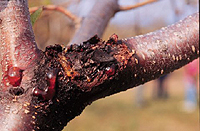
Leucostoma canker is one of the most
important diseases of stone fruit trees worldwide.
Symptoms and Signs
The physical appearance of Leucostoma canker depends on the part of the tree infected. Infections of small twigs appear as sunken discolored areas, often with light and dark concentric circles of dead tissue, usually around buds killed by winter cold or leaf scars from the previous year's foliage (Figure 1). Nodal infections are easily observed 2 to 4 weeks after bud break (Figure 2). Infected tissues darken with time and an amber gum may ooze from the infected tissue unless the twig is killed entirely (Figure 3). One-year-old shoots that develop in the center of the tree are especially susceptible to nodal infections and, if left untreated, rapid invasion of scaffold limbs and large branches to which these shoots are attached may follow. Branch cankers that result from such infections will have dead twigs or twig stubs at the center of the canker (Figure 4).

Figure 1 |
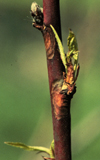
Figure 2 |

Figure 3 |
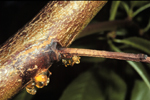
Figure 4 |
Cankers that form on the main trunk, branch crotches, scaffold limbs, and older branches are the most conspicuous expression of infection (Figure 5). Dead scaffold limbs comprise a symptom called “flagging” that are recognizable at a great distance from infested orchards. Cankers are elliptical, parallel to the long axis of the stem. Usually the first external symptom of such cankers is the copious production of amber-colored gum. Gum production is a natural host response to irritation, but gum production due to infection by Leucostoma spp. is excessive. As the canker ages, the gum becomes dark brown, and the infected bark dries and cracks open exposing blackened tissue beneath. Leucostoma canker can occur on weakened branches without the production of gum, especially if winter injury precedes infection.

Figure 5 |
Beginning in late spring and continuing through summer, the tree grows rapidly and resists further penetration of the fungus into healthy tissues. During this time, the tree may form a callus ring around the canker, but the fungus usually invades this tissue again in late fall or early spring when the tree is dormant and cannot actively resist penetration. The yearly alternation of callus production and canker extension produces a canker with concentric callus rings. When tree defenses are compromised by environmental stresses, callus production may be inhibited and cankers may appear more diffuse.
Branch or twig infections may result in foliar symptoms during the growing season. Leaves on an infected branch often turn yellow, droop, and may wilt and die. Dead twigs and branches are usually covered with a multitude of pin-head-sized black structures erupting through the dead bark, which contain the asexual reproductive structures of the pathogen (Figure 6).

Figure 6 |
Pathogen Biology
The fungi that cause Leucostoma cankers on stone fruits, Leucostoma cinctum and L. persoonii, are ascomycetes in the order Diaporthales, family Valsaceae. The imperfect (anamorphic) stages of these fungi, Cytospora cincta (=Leucocytospora cinctum) and C. leucostoma (=L. persoonii), respectively, are commonly encountered in the field. The morphological differences between the two species are often difficult to discern. Pycnidia form in cankers and on killed twigs and branches distal to cankers, appearing as quickly as 2 to 3 weeks or up to 6 months after the death of the bark. In irrigated regions, late summer water stress of infected trees can accelerate pycnidial production. Pycnidia are black on the surface, gray to grayish-brown internally, and underlain by a black layer. Development of pycnidia is first evident as pinhead-sized swellings, the top of which ruptures to expose the disc of the stroma. The disc of L.persoonii has a white or frosted appearance (Figure 7), whereas that of L.cinctum is gray to brownish-gray. Mature pycnidia under moist conditions extrude flesh- to orange-colored tendrils, or cirri (Figures 7, 8), containing thousands of conidia (Figure 9). Exudation ensues within minutes after wetting. The sexual reproductive structures (perithecia containing ascospores) (Figure 10) form much later, often 2 to 3 years after the original formation of pycnidia.

Figure 7 |

Figure 8 |

Figure 9 |

Figu |
Disease Cycle and Epidemiology
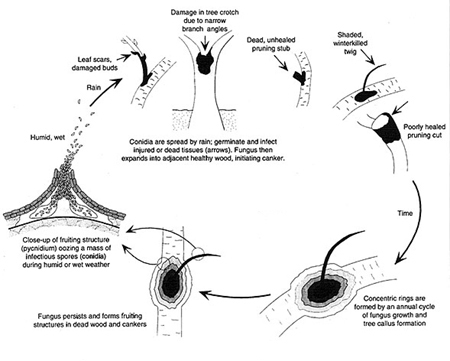 ycle
ycleEpidemiology
Leucostoma pathogens can invade the host only if the host is predisposed to infection through mechanical wounding or freeze injury. In mature peach and nectarine orchards where L.cinctum is the primary pathogen, many new infections appear at the nodes on one-year-old shoots. The pathogen enters the node through leaf scars or dead buds during the dormant season. Small twigs killed by L.cinctum are pathways by which the pathogen can reach older limbs and initiate cankers that may then result in death of large portions of the tree. Many new infections also take place at pruning wounds, and the fungus most often isolated at these sites is L.persoonii. Generally, pruning cuts are most susceptible if they are made early in the dormant season, but many pruning cuts made in the spring can become infected. At temperatures from 14 to 20 °C (57 to 68 °F), L.persoonii can initiate necrosis, however lesion expansion is limited by host defense reactions. At 2 to 8 °C (35 to 46 °F), initial lesion expansion is slower, however the total branch area colonized is larger and host reaction is more limited. In general, cankers will be smaller as the number of days above 10 °C (50 °F) increases.
The primary inoculum for new infections is conidia. The role of ascospores in the disease cycle remains to be determined. Conidia are most abundant under the cool, moist conditions of late fall and early spring (maxima from November through March) but are present throughout the year, depending upon rainfall. In irrigated regions conidia are potentially present whenever water is available. There are significant correlations between spore capture for L.persoonii and L.cinctum and the number of hours that temperatures are between 10 and 15 °C (50 and 60 °F), the duration of wetness, and the length of time that relative humidity is above 90%. Conidia are resistant to desiccation when contained within the cirrus; however, upon release by water and subsequent drying, most of them die within six hours. The agents involved in dispersal of inoculum have not been established conclusively for these fungi. Short-range dispersal of conidia indicates rain or wind-driven rain as dispersal agents. Localized splash dispersal also may contribute, as does impact sprinkler irrigation. Ascospores are discharged forcibly into the air following rain showers at any time of the year when rainfall occurs, but they are most abundant in late spring and early autumn. Spread of L.persoonii may occur also via infested pruning tools, birds, and possibly by the shot-hole borer (Scolytus rugulosus), although these are minor compared to air, wind-blown rain, and local splash and washin
g.
Disease Management
Management of Leucostoma canker is based on preventative measures designed to decrease winter injury and insect damage, promote optimum plant health, and facilitate healing of wounds and other injuries. As with any other disease, once it is established in an orchard, new infections are exceedingly difficult to control.
Cultural Management
Establishing new orchards: Nursery stock should be disease-free and not excessively large (greater than 11/16 caliper (0.6875 inches or 1.75 cm diameter)). Trees with small cankers on lateral branches may be planted if they are pruned so that at least 10 cm (4 inches) of healthy tissue below the canker is removed. Examine all trees closely. Plant trees immediately after receiving them from the nursery to avoid any additional stress. Protect trees from peach tree borer with an appropriate insecticide. Newly planted trees should be pruned when their buds begin to break and trees should be pruned back to about 102 – 114 cm (40 - 45 inches) to promote wide-angled branching. Small trees can be pruned to whips, but four to six side branches on larger trees should be pruned to two or three nodes since trunk buds may not develop. Trees should be inspected after growth begins, and any dead branches should be removed.
Site selection: Proper site selection for new peach plantings is essential if young trees are to enter their productive years free of disease. Sites should have deep, well-drained soil and good air circulation to minimize the chances for winter injury. Grade the site for proper surface drainage. Tile drainage systems should be installed where feasible and whenever natural drainage is impeded. New plantings should be reasonably isolated from sources of inoculum. Young trees should not be planted adjacent to older, heavily infected peach blocks and the down-wind side of older blocks should be avoided. Interplanting young trees with older, diseased trees may appear economical; however, young trees planted in this way are at a much greater risk for developing cankers and have a shorter productive life than young trees planted in solid blocks.
Orchard care: Sustainable management of Leucostoma canker results from the integration of several management strategies. Optimum disease management is achieved when all the practices listed below are followed.
Insect and disease control. Control oriental fruit moth and peach tree borer even in the first few non-bearing years. These insects can cause serious damage, and their feeding activity creates infection sites for Leucostoma spp. It is also important to control brown rot because twig infections caused by the brown rot fungus are often subsequently invaded and then enlarged by Leucostoma spp.
Mound soil at the bases of trees. This practice drains water away from the trunk and may prevent direct cold temperature injury to the crown. It also may prevent the formation of ice collars which could cause physical injury. Do not use gravel to fill depressions around the bases of trees. Where high wind and resulting tree movement causes open areas in the soil at the ground line, these may be most effectively filled in with sand.
Orchard floor management. In clean cultivation management systems, cease cultivation and sow a cover crop within 3 weeks of early fruit drop. Sod management with trickle irrigation, in addition to maintaining tree growth and fruit size, has the added benefit of making trees more resistant to Leucostoma spp. by improving tree health.
Train trees properly. Trees must be trained during the first season so that tree branches develop the wide crotch angles that are necessary for long orchard life. Where narrow crotch angles form, the tissue in the crotch is susceptible to winter injury, invasion by borers, and the trapping of moisture that favors spore germination. Also, portions of bark become included in narrow crotches where normally there should be solid wood, thus making the branch more likely to split when bearing a heavy crop. Wire spreaders or wooden spreaders with nails should be avoided because they injure the bark which may then become infected by Leucostoma spp.
Deter rodent injury. Rodent damage should be prevented with wire or plastic guards. Plastic wrap-around guards should be removed each summer because they may delay hardening of the wood in late fall; they may harbor boring insects and interfere with trunk sprays for borer control. Latex paint with thiram (fungicide) also discourages rodent feeding.
Optimize cold tolerance. Low temperature injury is always a potential problem with stone fruits. This injury occurs to buds, twigs, branches and branch crotches, and trunks. Cold temperatures can injure peach trees early in the winter before the trees are completely acclimated to the cold. Practices to avoid include excessive or late fertilization with nitrogen and late season cultivation.
Southwest-injury or sun scald is caused by the warming of the bark by direct sunshine on the south and west exposures of the trunk and scaffold limbs and may occur even during relatively mild winters. This injury may be the most damaging because it occurs on trunks, scaffolds, and crotches. These sites are commonly infected by Leucostoma spp. To avoid southwest injury, trunks and scaffolds should be covered with white latex paint which can reduce bark temperatures on sunny winter days.
Prune correctly and at the proper time. Infection at pruning cuts (Figure 12) is less frequent when pruning is delayed until late in the spring. The more rapidly that a wound heals, the less risk there is for infection. Wound healing is temperature-dependent; therefore pruning should be delayed until the first forecasts of warm, dry weather. Approximately 390 accumulated degree-days from the time of wound initiation (base = 0 °C) are required for complete wound healing to occur. In general, any practice that promotes tree health promotes more rapid healing. Pruning should be well planned each year so that large cuts, which heal more slowly, are minimized. Avoid leaving susceptible stubs. When pruning side branches from larger limbs, the cut should be made just beyond the ridge of thickened bark where the smaller branch joins the larger limb (Figures 13 – 15). The branch bark ridge should not be removed because it is in this region where the most rapid wound healing occurs. On one-year-old wood, the ridge of thickened bark is slightly inset, and it is difficult to make the proper cut. In this situation, cut as close as possible to the larger branch without injuring it or leaving a noticeable stub. Prune to open the center of trees to light penetration because shaded branches are weakened and more susceptible to winter injury and Leucostoma infection (Figure 16). Remove all dead and weakened wood and burn it immediately. In irrigated regions avoid summer pruning during irrigation events.
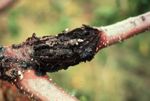
Figure 12 |

Figure 13 |

Figure 14 |

Figure 15 |

Figure 16 |
Surgically remove cankers. Cankers should be removed, and (if possible) burned, buried, or moved out of the orchard (Figure 17). Cankers on trunks and large limbs can be removed surgically in mid-summer when trees heal most rapidly. Surgery should be performed in dry weather with a forecast of dry conditions for at least three days. During surgery, remove all diseased bark around the canker and about 4-5 cm (1.5-2 inches) of healthy tissue from the sides and ends, respectively. Disinfest cutting tools between cuts with an alcohol or bleach solution. The resulting wound when finished should have a smooth margin and be slightly rounded above and below to favor rapid wound closure. The practice of covering pruning cuts in spring with a thiram-latex paint mixture provides some degree of protection against fungal infection. Sites of surgery heal best if left uncovered.

Figure 17 |
Tree fertilization. Trees under stress are more susceptible to Leucostoma canker. Practices that promote tree health minimize the damage resulting from infection by these pathogens. Nitrogen fertilizer should be applied in early spring to avoid inducing late, cold-susceptible growth in the fall. Use leaf analysis to determine proper fertilization amounts so that fertility is balanced and not excessive. Foliage should show a healthy green color and terminal growth should be about 30 cm (12 inches) on bearing trees and 46-61 cm (18 - 24 inches) for non-bearing trees. Trees with pale, nitrogen deficient leaves are more susceptible to infection by Leucostoma spp. Balance nitrogen fertilizer application with an adequate supply of potassium.
Irrigation management. In irrigated orchards with impact sprinklers, ensure that water streams do not impact directly on canker surfaces. Also keep sprinkler anglers as low as possible. In severely infested orchards consider changing to drip or microsprinkler irrigation. Avoid summer pruning during and immediately following irrigation sets. Avoid under-tree impact sprinkler irrigation systems - they are extremely efficient at disseminating the canker pathogens.
Genetic resistance
Cultivar selection is important and only cultivars tolerant of cold temperatures should be planted. No commercial cultivars are immune or highly resistant to the Leucostoma canker pathogens. Although there is no known immunity to the fungi that cause Leucostoma canker, cultivars that are tolerant of cold conditions may vary in their ability to tolerate or resist infections. Up-to-date listings of cultivars are often available from local extension offices.
Biological control
There has been much interest in biocontrol agents for Leucostoma canker because the disease is so difficult to control with standard cultural and chemical treatments. Some organisms are antagonistic to Leucostoma, but none has been developed to the point where it provides a practical level of disease control.
Chemical Management
There are no fungicides registered specifically for control of Leucostoma spp., and efficacy trials have produced conflicting results. The combination of captan and thiophanate-methyl, when used for brown rot blossom blight control, may provide recent pruning cuts some degree of protection against infection by L. persoonii. Demethylation-inhibiting (DMI) fungicides have very little activity against L. persoonii. The application of canker paints during moist weather should be avoided.
Significance
Leucostoma canker of stone fruits is most severe on cultivated crops in orchards and ornamental plantings. It is a minor problem on Prunus species found in natural ecosystems. A related fungus species, Leucocytospora kunzei, causes Leucostoma canker (or Valsa canker) of ornamental blue spruce (Picea pungens), Norway spruce (Picea abies), Engelmann spruce (Picea engelmannii), and Douglas-fir (Pseudotsuga menziesii).
Leucostoma canker, also called perennial canker, Cytospora canker, and Valsa canker, is an important disease of peaches, nectarines, and sweet cherries in areas with cold winters, including Canada and the northern fruit-growing regions of the United States. Leucostoma canker also is associated with the complex set of factors that result in the peach tree short life syndrome in the southeastern United States, and is important on other stone fruits including prune and plum in California and Idaho. In Europe, the disease is important on apricot, peach, sweet cherry, and is part of the disease complex of stone fruits called 'apoplexy'. Leucostoma canker also occurs in South America and Japan.
Leucostoma persoonii has been reported on Prunus, Cydonia (quince), Malus (apple, crabapple), Pyrus (pear), Sorbus (mountain ash), and Populus (poplar and aspen).L. cinctum has been reported on Crataegus (hawthorn), Prunus, Malus, and Robinia (locust). However, the disease is most commonly found on cultivated peaches, nectarines, plums, and cherries. The first observations of peach tree cankers caused by Leucostoma spp. were made in 1900 in western New York, and a few years later in Missouri. The disease was reported in southern Ontario in 1912. Leucostoma canker reduces the bearing surface of productive trees, shortens tree longevity, and significantly increases labor costs related to disease management.
Young, infected twigs may die during the first year of infection. Larger branches often take several years to display severe damage. Infected trees decline and become more symptomatic with each growing season. Infections often result in the general deterioration and death of the host. The stress placed on the tree may also make it susceptible to infections by other pathogens.
Economic losses accumulate as cankered limbs die or break from the stress of carrying a normal crop of fruit. The portions of a branch distal to a canker may become less productive, and cankers enlarge to girdle a branch and kill it. Trees with multiple infections show markedly reduced productivity. Because peach trees are pruned to support 3 to 4 main scaffold limbs, loss of one or two of these main limbs to Leucostoma canker represents 25 to 50% loss of fruit production.
It is very difficult to manage this disease once it is well established. Regular monitoring of susceptible plants, proper pruning and effective surgery should be a priority for all commercial growers and home gardeners.
Selected References
Bertrand, P. F. and H. English. 1976. Release and dispersal of conidia and ascospores of Valsa leucostoma. Phytopathology 66:987-991.
Biggs, A. R. 1989. Integrated approach to control Leucostoma canker of peach in Ontario. Plant Dis. 73:869-874.
Northover, J. 1976. Protection of peach shoots against species of Leucostoma with benomyl and captafol. Phytopathology 66:1125-1128.
Schulz, U., and A. Schmidle, 1983. Zur Epidemiologie der Valsa-Krankheit. Agnew. Bot. 57:99-107.
Tekauz, A. and Z.A. Patrick. 1974. The role of twig infections on the incidence of perennial canker of peach. Phytopathology 64:683-688.
Willison, R. S. 1936. Peach canker investigations. II. Infection studies. Can. J. Res. Sect. C 14:27‑44.
